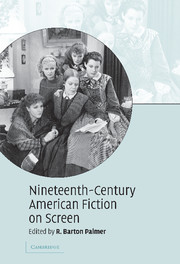Book contents
- Frontmatter
- Contents
- List of illustrations
- Notes on contributors
- Acknowledgments
- Introduction
- 1 A very American fable: the making of a Mohicans adaptation
- 2 Romancing the letter: screening a Hawthorne classic
- 3 The movies in the Rue Morgue: adapting Edgar Allan Poe for the screen
- 4 Readapting Uncle Tom's Cabin
- 5 Screening authorship: Little Women on screen 1933–1994
- 6 Melville's Moby-Dick and Hollywood
- 7 Screening male sentimental power in Ben-Hur
- 8 John Huston's The Red Badge of Courage
- 9 Translating Daisy Miller
- 10 Jane Campion's The Portrait of a Lady
- 11 The Europeans – and the Americans
- 12 Sister Carrie becomes Carrie
- 13 Hollywood and The Sea-Wolf
- 14 An untypical typicality: screening Owen Wister's The Virginian
- Filmography
- Index
1 - A very American fable: the making of a Mohicans adaptation
Published online by Cambridge University Press: 22 December 2009
- Frontmatter
- Contents
- List of illustrations
- Notes on contributors
- Acknowledgments
- Introduction
- 1 A very American fable: the making of a Mohicans adaptation
- 2 Romancing the letter: screening a Hawthorne classic
- 3 The movies in the Rue Morgue: adapting Edgar Allan Poe for the screen
- 4 Readapting Uncle Tom's Cabin
- 5 Screening authorship: Little Women on screen 1933–1994
- 6 Melville's Moby-Dick and Hollywood
- 7 Screening male sentimental power in Ben-Hur
- 8 John Huston's The Red Badge of Courage
- 9 Translating Daisy Miller
- 10 Jane Campion's The Portrait of a Lady
- 11 The Europeans – and the Americans
- 12 Sister Carrie becomes Carrie
- 13 Hollywood and The Sea-Wolf
- 14 An untypical typicality: screening Owen Wister's The Virginian
- Filmography
- Index
Summary
In 1936 the second major screen version of James Fenimore Cooper's (1789–1851) The Last of the Mohicans was released by a small outfit, Reliance Pictures, through United Artists. The film did very well at the box offices, and made a star of its lead male, Randolph Scott. Curiously absent from histories of 1930s Hollywood cinema, it has been fondly remembered by many viewers, and still plays on television quite regularly. It also provided the basis for Michael Mann's 1992 remake; Mann credits the screenplay by Philip Dunne as a prime source for his own ideas. In 1997 we published a book about the long and extensive history of adaptations of Mohicans, across the media of film, television, animation, and comic books. We tried to set the 1936 film in its production and cultural contexts. And in one important respect we got it wrong. This essay recounts what we discovered when an opportunity came subsequently to do further research in the archives. A very telling story emerges, which has implications far beyond this particular film.
Cooper's novel was originally published in 1826. More than any other, it made his name as an “American author.” Not the first, it was undoubtedly the best-known of his “Leatherstocking” tales which tell the life of Nathaniel Bumppo, or Hawkeye, the frontiersman who fictionally patrolled the forests of the North East – and who encountered the real circumstances of the French and English wars for control of America.
- Type
- Chapter
- Information
- Nineteenth-Century American Fiction on Screen , pp. 9 - 28Publisher: Cambridge University PressPrint publication year: 2007



